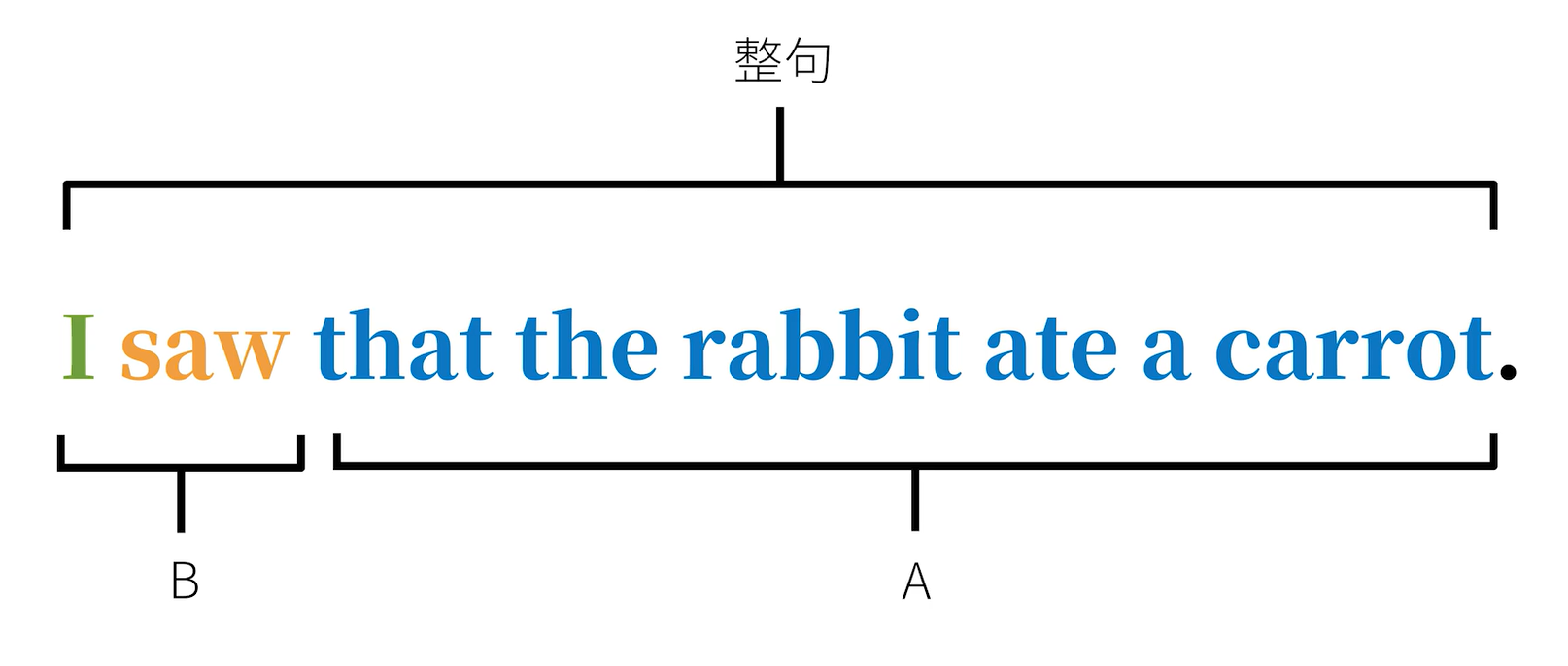参考资料:
写在前面
语法的目的是让我们更好地使用语言,因此理解句子想要表达的意思比理解语法本身更重要(同一个句子可能有不同的语法分类,这不是我们需要关心的)
什么是从句?
在英语中,句子的大类型有三个:简单句(不能再进行拆分)、复合句(简单句和简单句用连词连接,不分主次)和复杂句(主句+从句,从句充当句子的某种成分)

在一个完整的句子中,成分 A 是 B 的附属,服从 B ,不能独立成句,这里的 B 就是主句,A 就是从句
从句的分类
- 按句子成分来分:
- 主语+动词 主语从句
- 主语+动词+宾语 宾语从句
- 主语+动词+间接宾语+直接宾语
- 主语+动词+宾语+宾语补语 宾语补语从句
- 主语+动词+主语补语(表语) 表语从句
- 定语、状语、同位语 定语从句、状语从句、同位语从句
- 按词性分类
- 名词性从句:主语从句、宾语从句、表语从句、宾语补语从句、同位语从句
- 形容词性从句:定语从句
- 副词性从句:状语从句(可细分为时间状语、地点状语、条件状语等等)
定语从句 (形容词性从句)
中英思维方式
Example
例句:
- 英文:I am reading a book. 中文:我正在读一本书
- 英文:i am reading a book that my mother bought. 中文:我正在读一本我妈买的书
在上面的 2 个句子中,句子 1 是一个简单句,只包含了主谓宾三种词性;句子 2 是一个复杂句,其中 my mother bought 作为定语修饰 book
- 中文中,名词前的修饰语很好区分,可以表示为:好看的书、我妈给我买的书、我妈昨天下午在新华书店给我买的书,固定结构为:形容词/句子+的
- 但在英语中,单个/多个形容词,或副词+形容词作定语也是放在被修饰词之前,例如:I am reading an interesting book. 我正在读一本有趣的书;但如果表示我正在读一本我妈买的书,翻译成英文则为:i am reading a book that my mother bought.
book that my mother bought,可以理解为在被修饰的词后,添加另一个和它有关系的词,然后再把这个新词放到另一个句子中,进行补充说明。 语法上这个新词 that 叫做关系词/引导词,它之前被修饰的词叫做先行词,另一个句子就是定语从句
句子的结构可以被归纳为: a
关系词
关系词可以分为关系代词和关系副词
-
关系代词
that I bought. The man who is reading a book is a teacher. The man whom I saw yesterday is a teacher. The man whose favorite food is noodles is a teacher. The food which the teacher likes is a corrot.
that、who、whom、whose、which The rabbit is eating a carrot
唯一,我们一般用 that;当先行词是多选一时,我们一般用 which 例如:
- He is the kindest person that I’ve ever seen. (他是我见过的最善良的人)这里的先行词 person 指代的是最善良的人,是唯一的,因此只能使用 that,而不能使用 which
- I am reading a book that my mother bought. 也可以替换为 I am reading a book which my mother bought. 因为先行词 book 不止一个
-
关系副词 where、why、when
place where (at which) the man read books. This is the reason why (for which) the man keeps studying. That was the day when (on which) the man read books for the first time.
关系副词和关系代词的用法基本一致,只不过它们在句子中的词性是副词,我们也可以把关系副词转化为关系代词(关系副词=介词+which),例如: This was the
限定性/非限定性定语从句
限定性定语从句限定了先行词的范围
非限定性定语从句没有限定先行词范围
Example
例子:
- He is reading the book which is on the table. (限定性定语从句)which 前的先行词是 book,表示有很多本书,强调的是看放在桌子上的那本书
- He is reading the book, which is on the table. (非限定性定语从句)没有强调说明是那本放在桌子上的书,而是直接表达了两个观点:1. 他正在看书;2. 他看的那本书在桌子上
非限定性定语从句也可以指代整句话,例如:The rabbit ate the carrot, which was not surprising. 这里的 which 指代的是 the rabbit ate the carrot 这一整句话
宾语从句
定义:从句在整个复杂句中做宾语
-
确定信息作宾语
that the man read books. 我看见了这个男人读书 在这个句子中,the man 作为确定信息被放在宾语位置
I saw
-
不确定信息作宾语(注意和疑问句做区分)
where the man read books. I saw whether the man read books. I saw what the man read. I saw who read books. I saw when the man read books. I saw how the man read books. 在上面这些句子中,被修饰的对象是不确定的,因此我们采用关系代词、关系副词作为引导词,需要注意的是与疑问句做区分,不是看到副词都加does
I saw
Attention
宾语从句中的引导词 that 可以省略,其它引导词都不可省略! 但某些情况下 that 不可省略,例如: I didn’t know that the man read books and that you saw it. 我不知道那个男人看书,而且我也不知道你看到了 如果去掉 that 则变成了: I didn’t know
thatthe man read books andthatyou saw it. 这句话意思可以理解为,我不知道那个男人看书,但你看见了
表示意见的宾语从句,否定时需要特别注意:
Note
肯定形式: I think (that) … 我认为… I believe (that) … 我相信… I expect (that) … 我期望… 否定形式: I don’t think (that) … 我不认为… I don’t believe (that) … 我不相信… I don’t expect (that) … 我不期望… 在否定句中,否定词要放在最前面,而不是放在从句中
主从时态一致
一般情况下,宾语从句的时态要和主句保持一致,例如:
I know (that) he is right. 我知道他是对的 ✅
I knew (that) he is right. 我知道他是对的 ❌, 正确的改法应该改 is 为 was
除非是客观现象,例如:
I knew (that) the sun rises in the east. 我知道太阳从东边升起
Note
太阳从东边升起这件事是客观的自然规律,因此从句用一般现在时
be+形容词+that…
I am sure ( confirm) that there is a carrot on the table.
I am happy ( like) that there is a carrot on the table.
I am afraid ( fear) that there is no carrot on the table.
这是一个有分类争议的句型,它可以同时被分类为宾语从句,同位语从句和原因状语从句,不过具体分为哪个类不重要,语法主要辅助我们理解句子的意思,只要句子意思理解正确,怎么分类都没问题!
主语从句
Example
The fact is obvious. 这个事实是明显的。 转换成主语从句:(That) the sun raises from the east is obvious. 太阳从东边升起这件事是显然的。 这是一个典型的主语从句,在这个句子中,太阳从东边升起这个从句作为从句,承担主句中的主语成分
当然,与宾语从句一样,除了确定信息可以做主语,不确定信息也可以做主语,例如:
What raises from the east is obvious.
Where the sun raises from is obvious.
…
主语从句需要有引导词开头,否则就不构成从句了(当然,that 在一般情况下可以省略)
形式主语
考虑一个复杂的句子:That the hungry rabbit had already eaten a carrot for dinner this evening is obvious. 饥饿的兔子在晚上吃晚餐的时候已经吃了一个胡萝卜这件事是显然的。
这个句子存在一个严重的问题:头重脚轻,并且关键信息 obvious 在句子的最后才说出来,非常不利于人们在交流中的信息表达,于是就有了 形式主语
修改后的形式主语是这样的:
It is obvious that the hungry rabbit had already eaten a carrot for dinner this evening. 很明显,饿了的兔子今天晚饭已经吃了根胡萝卜。
在这个句子中,It 是一个形式主语,它本身没有意义,但是它代表的是之后真正的主语,即 that the hungry rabbit had already eaten a carrot for dinner this evening